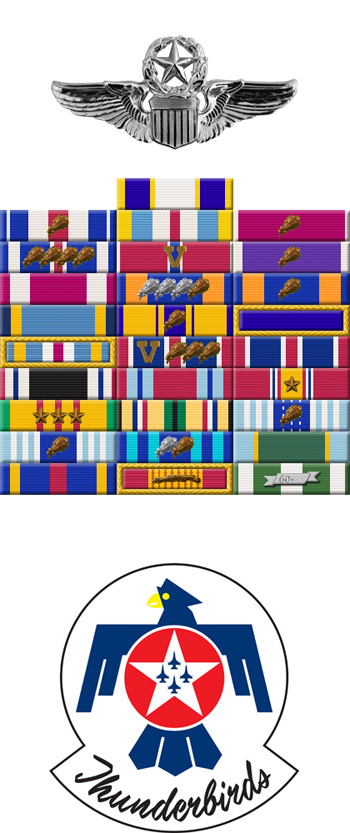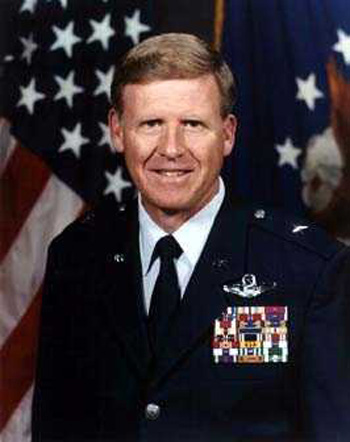
|
James D. Latham |
 |
|||
| Rank, Service | ||||
Brigadier General O-7, U.S. Air Force |
||||
| Veteran of: | ||||
|
||||
| Tribute: | ||||
Jim Latham was born in 1946 in Sedalia, Missouri. He was commissioned through the Air Force ROTC program at Kansas State University on February 2, 1969, and went on active duty on March 21, 1969. Latham next attended Undergraduate Pilot Training and was awarded his pilot wings at Vance AFB, Oklahoma, in March 1970. After completing survival school and OV-10 Bronco combat crew training, he began flying combat missions in Southeast Asia with the 23rd Tactical Air Support Squadron of the 56th Special Operations Wing at Nakhon Phanom Royal Thai AFB, Thailand, in August 1970. Latham completed his first tour of duty in August 1971 and then completed F-4 Phantom II combat crew training in May 1972. He then served a second tour in Southeast Asia, this time with the 435th Tactical Fighter Squadron of the 8th Tactical Fighter Wing at Ubon Royal Thai AFB, Thailand, where he served from May 1972 until he was forced to eject over North Vietnam and was taken as a Prisoner of War on October 5, 1972. After spending 175 days in captivity, Capt Latham was released during Operation Homecoming on March 29, 1973. He was briefly hospitalized to recover from his injuries at Sheppard AFB, Texas, and then completed pilot requalification training at Randolph AFB, Texas, and George AFB, California, from June to October 1973. Capt Latham then flew F-4s with the 417th Tactical Fighter Squadron of the 49th Tactical Fighter Wing at Holloman AFB, New Mexico, from October 1973 to November 1976. His next assignment was as weapons officer for the 43rd and 18th Tactical Fighter Squadrons under the 21st Composite Wing at Elmendorf AFB, Alaska, from November 1976 to November 1978, followed by a tour of duty as right wingman and operations officer with the Thunderbirds from November 1978 to January 1981. He then attended Armed Forces Staff College at Norfolk, Virginia, from January to September 1981, before serving as an F-16 Fighting Falcon pilot, weapons officer, and flight commander with the 430th Tactical Fighter Squadron of the 474th Tactical Fighter Wing at Nellis AFB, Nevada, from October 1981 to June 1982. Maj Latham then served another tour with the Thunderbirds, this time as its commander flying the number 1 airplane, from June 1982 to February 1984. Col Latham then served as commander of the 16th Tactical Fighter Squadron of the 388th Tactical Fighter Wing at Hill AFB, Utah, from May 1984 to July 1986. He attended National War College at Fort McNair, Washington, D.C., from July 1986 to June 1987, and then served as executive officer to the director of the Defense Security Assistance Agency at the Pentagon from June 1987 to July 1989. Col Latham was vice commander and then commander of the 432nd Tactical Fighter Wing at Misawa AB, Japan, where he served from August 1989 to July 1992. He served as commandant of Squadron Officer School at Maxwell AFB, Alabama, from August 1992 to June 1993, and then commandant of the Air Force ROTC program, also at Maxwell, from June 1993 to August 1994. Gen Latham next served as commander of the 20th Fighter Wing at Shaw AFB, South Carolina, from August 1994 to August 1995. During this time he was deployed as commander of the 4404th Composite Wing at Dhahran, Saudi Arabia, from April to July 1995. His final assignment was as assistant deputy under secretary of the Air Force for International Affairs at the Pentagon, where he served from September 1995 until his retirement from the Air Force on August 1, 1997. After his retirement from the Air Force, Jim went to work for Lockheed-Martin in Fort Worth, Texas. |
||||
|
||||

